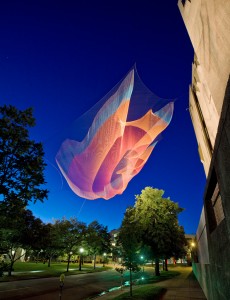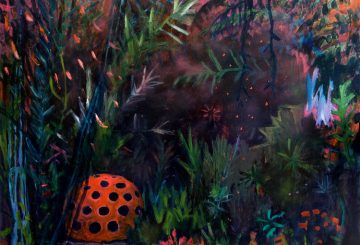Din Heagney talks to visiting US-artist Janet Echelman about her sculptural practice, one that has moved deep into techno-collaborative waters and right across the Pacific…
“Art has a way of getting at an issue from the inside,” says Janet Echelman, a 2011 Guggenheim Fellow whose immense ephemeral sculpture, Tsunami 1:26, explores some of the complex relations we have to our vast but fragile global environment.
“Lately I’ve become interested in engaging the international dialogue of ideas through my sculptures,” she says. “Using this as a handle into my art, I hope to create a shared experience of that interconnectedness – one that grasps you emotionally and intellectually. This experience transcends national boundaries.”
Janet Echelman, 1:26, 2011, installation view, Denver Colorado. Courtesy the artist. Photo: Peter Vanderwarker
Originally designed as a public commission in Denver Office of Cultural Affairs Public Art Program in Colorado, 1.26 pushes the ephemeral nature of public sculpture to a new level. The commission was intended to reveal contemporary relations between different nations in the Americas.
Echelman’s response took ideas of temporality and interconnections then combined them with a 3D computer simulation of the outcome of a Pacific-wide tsunami. This was around the same time as the Chilean earthquake in early 2010 – when NASA announced that the length of the average day had been shortened by one minute and 26 seconds as a result of quake shifting the Earth’s axis by 8cm.
Echelman’s sculpture looked directly into the interconnected nature of our planet, particularly between time and the oceans – what happens on one side of the Pacific is interwoven by nature across the expanse of ocean to have a planet-wide impact. Echelman also engaged engineers, architects and programmers to render conceptual drawings into AutoCAD models that could be remade in high tensile rope and woven into an enormous net.
The collaborative result is a physical representation of a massive disaster, yet it floats in the sky, defying its weight in both matter and meaning. Despite its vast bulk and weight, the work infringes gravity, with air currents interacting between the sculptural matrixes to create an ethereal movement.
Beyond the aesthetic, there is another level to Echelman’s practice. 1:26 is a palpable representation of a potentially disastrous event for civilizations on the Pacific Rim. By embedding measurements from the latest astronomical and oceanographic technology, she has revealed the ways in which science can directly collaborate with art to achieve the kind of positive conscious awareness that is so difficult to communicate, at least without sounding either sentimental or apocalyptic. Public works with complex messages and layered entry points like 1:26 can ultimately engage audiences without isolating them.
“I feel privileged to work with brilliant engineers, architects, landscape architects, lighting designers, and computer scientists,” she explains. “It expands the language with which I can speak as an artist.”
Also of interest is that Echelman takes high-end technology right back to the apparent low-end, to something handmade, ancient, but entirely vital – the net. Her work has often centred on nets, their crafted and hand-woven qualities, their versatility, and their multi-faceted structures. The net as both object and analogy draws on a rich history across cultures, bringing together utilitarian ideas around generational skills and local food sources.
“I’ve heard many different interpretations,” she replies, when I ask her about symbolism of the net in her work. “For instance, residents in Porto and Matosinhos in Portugal have claimed that the sculpture, She Changes, is about them. They feel a connection to the red and white netting, saying it alludes to the Portuguese era of sea-faring trade and discovery. Women’s groups have claimed it celebrates the history of lace and women’s work in Portugal’s history. They are all correct.”
In a very real sense, Echelman’s sculptures operate both materially and metaphorically. One could even read her work as a type of fishing for consciousness in public space – yet Echelman is clear that she wants people visiting to experience her work in their own ways: “It’s important that my work remain open, so I don’t want to prescribe what anyone should take away from the project.”
Tsunami 1:26 by Janet Echelman
23 September–23 October 2011
George Street Sydney (outside Town Hall)
Presented by the Powerhouse Museum and Sydney Art & About
www.artandabout.com.au/projects/tsunami-janet-echelman
www.echelman.com/


